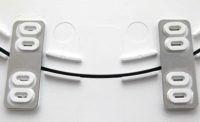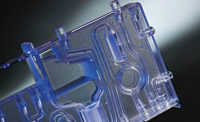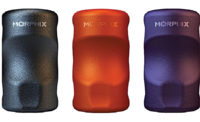Based in Malmö, Sweden, Rosti Group is a global injection-molding company and contract manufacturer to some of the world’s leading manufacturers in the packaging, consumer appliances, business machines, home automation, medical and automotive sectors. An exhibitor at the 2020 virtual ASSEMBLY Show, Rosti operates production facilities in China, Germany, Malaysia, Poland, Romania, Turkey and the UK.
The company’s portfolio includes everything from beverage caps to currency cassette modules for ATMs. Recently, we sat down with Karl Stillman, regional sales director at Rosti, to talk about part design and how to with contract manufacturers.
ASSEMBLY: What do Rosti engineers look for in a plastic part design?
Stillman: First, we need to clarify what the customer’s objectives are. Is the product manufacturable? What can Rosti do to optimize cost to customer, operational performance for Rosti, and sustainability for all.
We look at many areas of the part design. Is it feasible for injection molding? If not, Rosti will redesign the part and send an updated 3D CAD file back to customer with comments and a design analysis report showing before and after images and explaining the rationale for our suggestions to modify the design.
We consider the resin, too. Is it suitable for the purpose? Will it achieve the cosmetic and functional requirements that the customer has specified or, in the absence of such a specification, what Rosti engineers envisage to be the critical functional and quality requirements.
Finally, we think about assembly. What are the tolerance stack-ups? How do moving parts interact? Can the parts be easily assembled? Can error-proofing features be added?
ASSEMBLY: What are some common ways that Rosti engineers optimize parts?
Stillman: The most common input is on part design for moldability. Rosti’s core competence is injection molding. We have an extensive knowledge base that we draw upon for every new project. As a contract molder and manufacturer, we have exposure to many different designs and materials, so we are well-versed in what works and what does not work. With the help of our certified Autodesk Moldflow engineering team, we can quickly identify areas that will result in molding defects and proactively design these out.
We pay considerable attention to cosmetic defects. This is one area that design engineers do not understand well. There is a lot of information on designing mechanical structures, but aesthetics is often overlooked.
Cost optimization is another key area that we evaluate. Rosti has implemented many creative solutions over the years, including alternative materials, part consolidation, swapping metal parts for plastic ones (and vice versa), and the elimination of post-processing steps.
We are a service provider. In theory, anyone with injection molding machines can do what we do. What makes us stand out is our customer intimacy and continuous improvement attitude. Rosti is only successful if our customers are satisfied and profitable, which translates to repeat business for us.
ASSEMBLY: How does the intended method of assembly influence part design?
Stillman: One of the key steps in any new project is fact finding. In many cases, we’re only molding the parts, which will be assembled at the customer’s site. However, it’s very important to know the eventual assembly method, because that enables us to add value to the design. Knowing the downstream value chain and operations is key in our analysis.
For example, we conduct finite element analyses on snap fits, load-bearing members and pressure vessels. We can simulate various bonding technologies, welding methods and mechanical fasteners under dynamic loading conditions. We like to take a holistic view of the assembly process and the product’s operational conditions. Only by understanding risks can we advise our customers and add value to the product.
ASSEMBLY: How do the intended materials influence design?
Stillman: Other than variation in costs, different materials have different properties. For example, polycarbonate should not be used with alkaline aqueous solutions or aromatic and chlorinated hydrocarbons, since these would degrade and weaken the part. Whenever we work with multi-material assemblies, we assess the chemical compatibility to ensure that there will be a chemical bond between them. In cases where chemical bonding cannot be achieved, and the materials cannot be substituted, we would recommend design changes to facilitate mechanical bonding.
ASSEMBLY: Have Rosti engineers ever recommended a change in material or design?
Stillman: To be honest, the occasions where we do not offer design recommendations would be an easier number to quantify. The truth is, we provide recommendations and suggestions to our customers more often than not.
ASSEMBLY: How much do your customers typically know about molding processes?
Stillman: We have customers ranging from manufacturing immaturity to international corporations that have as long a history in plastic parts as Rosti does. That said, we do have customers that surprise us and have been able to teach us about a particular design or material application. We value these interactions, as nothing is ever black and white. There are always compromises and trade-offs to be made. Conversely, we also have customers that believe they have “been there and done it all,” so extra care must be taken to prepare supporting evidence for our proposals. This would include simulation data, past product data, theoretical calculations, prototype tooling and other information.
ASSEMBLY: Have Rosti engineers ever received a design and thought, “no way”?
Stillman: Yes, this happens several times per year. It’s all about understanding the boundary conditions of the parts, such as geometric envelope, usage conditions and assembly processes. From there, we dive into the design to realize a workable solution. This may result in significant design changes. There might be material changes, process changes or one part may have to be separated into two parts. We always find a solution by working closely with the customer.
ASSEMBLY: What sort of tests are done on the parts?
Stillman: This depends on the design intent of the part. Over and above the standard dimensional checking and our statistical process control, we measure surface roughness to single-digit nanometer deviations for optical parts. We assess mechanical strength for safety-critical parts. For in-mold decorated parts, we assess chemical resistance and scratch resistance of the artwork. We do peel strength testing for overmolding.
Our top two priorities are always safety and quality. These are at the forefront of all our design and process verification protocols.
ASSEMBLY: What can those tests tell you?
Stillman: These test can predict, on a statistical basis, whether our prototypes or our production processes are going to exceed the product’s quality requirements. We strive to be 100 percent confident in our process setup prior to production. In fact, we have developed a six-step process to qualify parts with as wide a process window as possible to ensure production stability. We also monitor the injection molding process.
ASSEMBLY: How has 3D printing affected your business?
Stillman: It’s had a huge impact. 3D printing can get designs from the screen into the designer’s hands quickly and cost-effectively.
However, that’s just the tip of the iceberg. We have learned from past experience that part designs do not always behave the same way when we transition from printed prototypes to molded parts. There are a number of reasons for this. The print material does not behave the same as the molded resin. The layering process results in anisotropic properties, which are not as homogeneous as molded parts. The molding process results in shrinkage and molding stresses in the parts.
That makes creating molds for prototype parts a gamble. It can take four weeks and tens of thousands of dollars to produce traditional molds for prototype parts. As a result, engineers must be confident in their designs before committing the time and resources to make molds.
That got us thinking: How could we get molded parts quicker and cheaper in the development phase? The answer was to print the mold, as well! It took a lot of development work, but we have perfected the process of 3D printing mold tooling. As a result, we can take a customer’s design from print to part in 72 hours. That includes design analysis, mold-flow analysis, part prototyping, tool prototyping and injection molding.
This is a critical success factor when engineers are trying to push design limits. We live in a world where if you are not progressing, you are going backwards. This process allows designers to “fail forward,” to iterate designs quickly and at a fraction of the traditional costs for molded parts.
Rosti Helps Produce Device for Rapid COVID Test
Rosti Group has helped a global molecular diagnostics company to begin manufacturing a COVID-19 saliva test, providing laboratory-quality results in 15 minutes. This will allow nonmedical personnel to obtain fast, on-site detection of the coronavirus at the point of need.
Rosti’s Digital Innovation Laboratory used 3D printing to create prototype injection-molding tools, which allowed engineers to have prototype parts for the test within 72 hours. Production tooling—32-cavity molds—was ready just five weeks later, and the diagnostics company began serial manufacturing of the test under ISO-13485 conditions.
“Solving the problem of quick COVID diagnostics testing is one of our priorities at Rosti,” says Karl Stillman, regional sales director at Rosti Group. “We are delighted that our 72-hour 3D printing capabilities made it possible for our customer to produce test kits quickly and cost effectively.”




